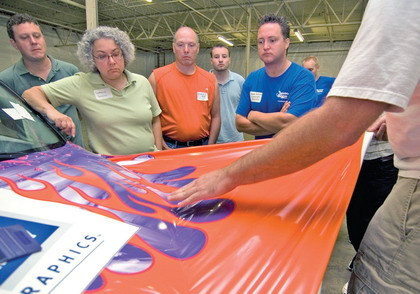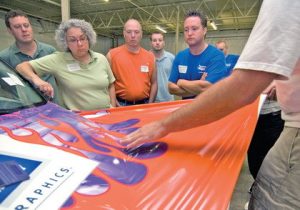During vehicle wraps’ formative years, trial and error was often the method service providers used to verify a media’s conformability, a printer’s color fidelity or a RIP’s success in rendering the original design intent. However, as wraps’ cost-effectiveness and versatility have made them increasingly ubiquitous, tools and materials that further enhance a signshop’s wrap-fabrication process.
Though such tools and materials may help fabricators efficiently render quality vehicle graphics, they’re not panaceas that guarantee a successful project. A basic understanding of how such equipment works and how to use them effectively is required to ensure efficiency for your customers and a healthy profit.
Rob Ivers, a Raymore, MO-based, vehicle-graphics professional, has applied vinyl graphics for 30 years and vehicle wraps for 15. He’s also a member of the Professional Decal Application Assn. and will be conducting vehicle-wrap demonstrations and tutorials at this fall’s SGIA tradeshow.
He said that, although new-generation vinyls may make the job easier, material overstretching and poor squeegee techniques remain the most common mistakes he sees among his students. The only solution to such shortcomings is practicing proper techniques through a proper training regimen.
“It simply comes down to demonstrating proper techniques, and then lots of repetition until you’ve mastered the skill. I compare the skills to a baby’s development; no child gets up and walks right away. There are stages of sitting up, crawling, walking, etc.; everyone falls down in the process. But, learning from someone else’s mistakes helps save a great deal of time and money.”
Advertisement
Though he praises modern films with air-egress technology, which eliminate bubbles, Ivers said wrinkles and edge lifting still present hurdles when installers use poor application techniques or overstretch vinyl. Also, he said current solvent-inkjet technology may create some issues.
“Solvents migrate to the adhesive and are usually retained because they’re trapped in the vinyl laminate and can’t outgas,” Ivers said. “This changes the vinyl’s properties and makes the adhesive bond less strong. The development of flexible, UV inks and printers will likely replace solvent-ink technology, and this will beneficial both in terms of ecology and a better finished product.”
Tom Elley, Oracal USA’s customer-education business manager and a 20-year, vehicle-graphics veteran, said vehicle wraps enjoy surging popularity because, although codes often tighten regulations on storefront signage, wraps aren’t subject to such scrutiny.
Many enrollees in Oracal’s Wrap Academy only have experience with plotter-cut graphics, which Elley said doesn’t often translate to printed wraps.
“With plotter-cut graphics, you’re dealing with a flat surface, and it’s OK to just drag the squeegee,” he said. “With inkjet graphics, you’re usually working with riveted or contoured surfaces, and squeegees require defter maneuvering.”
Elley also cited poor design as another earmark of an inexperienced, vehicle-wrap provider: “Excessive text or graphics that make a graphic illegible and too busy are counterproductive. It’s important to keep the message simple, or it will be lost.”
Advertisement
Elley includes Teflon® squeegees with one felt-covered side in his tool pouch. He eschews solid-felt squeegees because he thinks they don’t offer enough force to activate the material’s pressure-sensitive adhesive. Other staple tools include rivet brushes, heat guns or torches. Elley said it’s important to learn proficiency with both, because not every installation will allow electrical access to operate a heat gun.
He also uses Olfa disposable-blade knives (which he prefers because the blades snap away if necessary), air-release tools to alleviate air pockets, Stabilo pencils to mark key installation points, and a tape measure.
Joel Ross, Avery Dennison Graphics & Reflective Products Div. marketing-communications manager who coordinates the company’s approximately 30, annual, wrap-education seminars, said it’s important to use the hinge method for fleet grapnics – a central pivot that eases maneuverability – when applying films over rivets, deep contours and other complex surfaces. Also, he strongly advised against wet applications for vehicle graphics because the moisture can become trapped below the vinyl’s adhesive layers and will, almost invariably, cause it to lift away from the vehicle.


 Tip Sheet2 weeks ago
Tip Sheet2 weeks ago
 Photo Gallery3 days ago
Photo Gallery3 days ago
 Ask Signs of the Times5 days ago
Ask Signs of the Times5 days ago
 Real Deal2 weeks ago
Real Deal2 weeks ago
 Paula Fargo17 hours ago
Paula Fargo17 hours ago
 Benchmarks1 week ago
Benchmarks1 week ago
 Photo Gallery17 hours ago
Photo Gallery17 hours ago
 Women in Signs2 weeks ago
Women in Signs2 weeks ago













